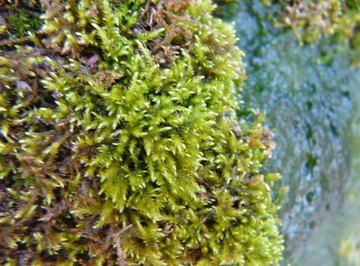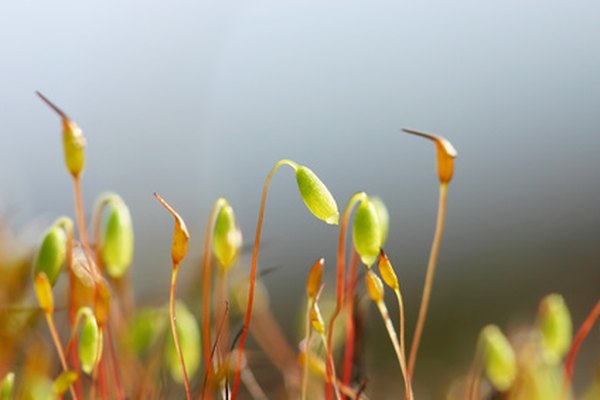
What is moss? According to Bellevue College, mosses are bryophytes, primitive plants believed to be among the first to develop the ability to live on land. Moss plants have no vascular tubes to transfer water or nutrients, and no true stems or roots. Environmental water sources and absorption limit moss plant size.
There may be as many as 15,000 species of mosses. Although unique species of moss grow in dramatically different habitats across the planet – from the arctic to the desert – all have basically the same structure.
Basic Moss Spores
The initial moss plant is a spore given off by the sporophyte that forms at the end of the moss plant’s “stem.” Released spores travel long distances on the wind and may remain viable for decades. Moss spores landing in suitable conditions divide and produce hairy filaments called protonemas, which are like thin plant threads that weave across the growing medium. Sprouting from the spore filaments, gametophytes form, held to the surface by rhizoids.
Main Structure of Moss
The main moss structure is the gametophyte, which functions like a moss’s “stem” and “leaves.” A moss "stem" is called the axis, and this part of the moss supports leaf-like structures.
Phyllids are the leaf-like structures that carry out photosynthesis, transforming sunlight into sugars the moss uses for food. Typically arranged in a spiral, moss “leaves” are usually one cell thick with ribs two or more cells thick down their centers. The cells of moss plants contain chlorophyll, the green pigment that is essential for the process of photosynthesis.
Does moss have roots? No, not really. Moss stems end in root-like strands called rhizoids, specialized to hold the moss to its growing surface. Rhizoids anchor moss plants to the surfaces they grow on, but they do not absorb water and nutrients like true plant roots.
Second-Generation Growth
The second moss structure is really a second generation. Moss reproduction occurs sexually, using separate plants produced at different times. The two separate kinds of moss plants are called gametophytes (which produce gametes) and sporophytes (which produce spores).
Gametophytes are tipped with either inverted cone-shaped areas (archegonia) or male reproductive organs (antheridia). Released sperm (antherizoids) need water since they swim to the archegonium. This is one of the main differences between bryophytes and vascular land plants – mosses need water for their sexual reproduction process.
Fertilization occurs once an antherizoid swims to an archegonium. Sprouting from the gametophyte tip after fertilization, a sporophyte holds itself in place by anchoring a foot in the archegonium.
Spore-Bearing Parts

The sporophyte stalk, called the seta, bears the sporangium (spore capsule) on its tip. One sporangium may produce up to one million spores. Maturing spore capsules are guarded by a covering called the calyptra that shrivels and falls off when the spores are mature. The calyptra can be a distinguishing part of a moss species, and they are often useful in identifying new mosses.
A cap called the operculum tops the capsule's opening under the calyptra. The capsule opening (peristome) can have teeth that help hold it closed. Matured spores are released when the capsule top ruptures and drift off to form new plants. Like the calyptra, the operculum and peristome of some moss species are highly identifiable.
Asexual Reproductive Parts
Mosses don’t depend on only sexual reproduction - they can also rely on asexual reproduction in order to produce offspring. Gametophytes have balls of unspecialized cells, called gemmae, attached to them. If broken off, each simple cell can bud to form a protonema that sends out lateral shoots.
New gametophytes develop from the shoots, ensuring the moss’s survival. These new gametophytes are genetically identical to the parent organism. Their simple structure and multiple reproductive methods allow mosses to thrive from the Arctic Circle to the equator.
References
Resources
About the Author
Beth Asher began writing in 1972 for a catalog company. She has written for schools and charities, including Star Workshop Foundation. She was a John Deere representative for nine years, manager of Brown's Blueberries and an advisory member of King County Small Farms Board and the Washington Association of Landscape Professionals. Asher holds a Bachelor of Science in computer networking from City University.
Photo Credits
Moss image by Yaroslav Knish from Fotolia.com
